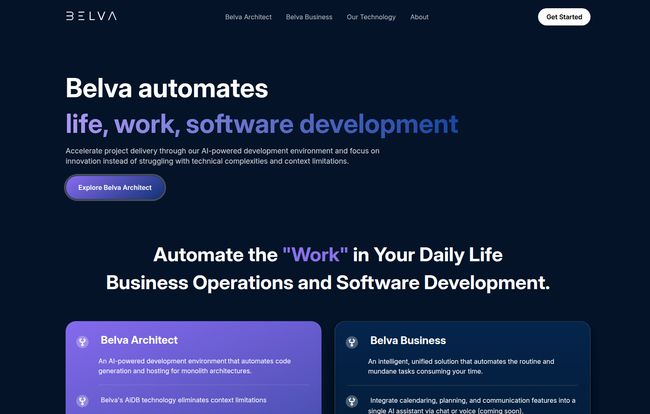In the world of SEO and software development, we're drowning in AI tools. Every week there's a new 'game-changer' that promises to write your content, debug your code, and probably walk your dog. Most of it is just marketing fluff wrapped around a slightly smarter autocomplete. It’s exhausting.
But every now and then, something pops up on my radar that makes me lean in a little closer. Something that isn’t just about tweaking a function or rewriting a paragraph, but about rethinking the whole... process. That's the vibe I got when I first stumbled upon Belva Architect. The claim? An AI-powered development environment that turns high-level system designs into actual, functional code. It’s a bold claim. A really bold one.
As someone who's spent more nights than I'd care to admit wrestling with boilerplate code and trying to decipher ancient legacy systems, the idea is more than just appealing. It’s the holy grail. So, I decided to put on my skeptic's hat, grab a strong coffee, and see if Belva Architect is the real deal or just another cog in the AI hype machine.

Visit Belva Architect
So What Is Belva Architect, Really?
Let's cut through the jargon. At its heart, Belva Architect is a platform where you can design a software system using UML (Unified Modeling Language) diagrams. You know, those flowcharts and box diagrams that architects love and junior devs sometimes dread. You create your blueprints—your class diagrams, sequence diagrams, and architecture layouts—and then the AI steps in. It takes that blueprint and... well, it builds the house. It generates the code, whether for a big, single-chunk monolith or a trendy network of microservices.
Think of it like this: traditionally, a software architect drafts a plan, hands it to a team of developers, and then hopes the final product matches the vision after weeks of translation and coding. Belva aims to bridge that gap directly. It’s like giving your lead architect a magic wand instead of just a pen, allowing them to bring their vision to life without getting lost in the syntactical weeds of ten different programming languages.
But the most intriguing part for me? It's not just for building new things. They claim it can tackle the beast that is legacy code.
The Key Features That Caught My Eye
I’ve seen a lot of tools, but a few of Belva's features genuinely stand out from the crowd. It’s not just one trick, but a combination of ideas that feels... cohesive.
From Blueprint to Building with UML-to-Code
This is the main event. The ability to generate code directly from UML diagrams is a massive shift. I've always found UML a bit... academic, something you do to satisfy a project manager before getting to the 'real' work. But Belva reframes it as the work itself. This visual-first approach could be a godsend for complex systems, allowing you to see the architecture and data flow before a single line of code is manually typed. It forces a level of discipline and planning upfront, which, let's be honest, could save us all from a lot of pain down the line.
Breathing New Life into Old Code
Now this, this is what gets my cynical heart beating a little faster. Tackling legacy code is like digital archaeology. It’s slow, it’s risky, and half the time you have no idea what the original builders were thinking. Belva Architect proposes a simple, almost unbelievable workflow: import an existing codebase, let the AI visualize its architecture for you (amazing in itself), and then use the same UML-based tools to refactor, modernize, or add new features. If this works as advertised, it could single-handedly justify its existence for thousands of companies stuck with aging, unmaintainable software.
Full Context Awareness is a Big Deal
We've all used AI assistants that have the memory of a goldfish. You give it a snippet of code, it gives you a suggestion, but it has no idea about the other 50,000 lines in your project. Belva claims to have full-context integration of entire code repositories. This means the AI isn't just looking at one file; it's aware of the whole project. It understands the dependencies, the existing patterns, the overall structure. This is a monumental leap. It’s the difference between asking a stranger for directions and having a seasoned local guide who knows all the shortcuts and back alleys.
Who Is This Actually For?
So, who should be rushing to try this out? In my opinion, the sweet spot for Belva Architect is experienced teams and leaders. Think software architects, senior developers, and CTOs. These are the people whose time is most valuable when spent on high-level design and strategy, not getting bogged down in implementation details. It’s also a potential superpower for startups that need to build and iterate on complex products at lightning speed.
On the flip side, it might not be the best starting point for a junior developer. Part of learning the craft is getting your hands dirty with the nuts and bolts. Abstracting that away too early could be a disservice. Also, if your project relies on a super-niche, obscure programming language or framework, you might find the AI's support a bit lacking, which is a fair trade-off.
The Good, The Bad, and The AI
No tool is perfect. Let's weigh the pros and cons from a real-world perspective.
What I'm genuinely excited about is the raw potential for speed and focus. Imagine cutting down your development cycles from months to weeks. Imagine your best engineers focusing purely on innovation and user-facing features instead of wrestling with deployment scripts and refactoring decade-old Java classes. The visual environment also democratizes understanding of the system's architecture. It makes complex systems more digestible for the whole team.
But let's be real, there are some caveats. The biggest hurdle is the reliance on UML. If you or your team aren't comfortable with it, there's going to be a learning curve. It's a skill that has fallen out of fashion in some circles, so it might feel like a step back for some agile-focused teams. And then there's the question of control. Handing over code generation to an AI means giving up some fine-grained control. For obsessive perfectionists (you know who you are), this might be a tough pill to swallow. You're trusting the AI to make sensible, efficient choices, and that trust needs to be earned.
Let's Talk Money: The Belva Architect Pricing Puzzle
Alright, the all-important question: what does it cost? I went to check out their pricing page to get the details for you. And, well... I was greeted with a 404. Page not found. Classic. You can't make this stuff up, and honestly, it adds a strange layer of authenticity to the whole discovery process.
However, from the information I could find, it seems they use a credit-based system. The term I saw was "Belva Architect 500 Agent Hours". This suggests a pay-as-you-go model where you're charged for the AI's processing time—the 'hours' it spends thinking, generating code, and managing your deployments. I actually prefer this to rigid monthly subscriptions, as it scales with your usage. But the ambiguity means you'll definitely want to get in touch with them directly for a clear breakdown. Don't just take my word for it.
Frequently Asked Questions about Belva Architect
Is Belva Architect a no-code platform?
Not exactly. It's more of a 'low-code' or 'AI-assisted code' platform. It automates the heavy lifting of writing code, but it's designed for developers and architects who understand software principles. You're still building a real, complex application, just at a much higher level of abstraction.
What kind of projects is it best for?
It seems ideal for building new, complex applications (both monoliths and microservices) where architecture is a primary concern. Its legacy modernization feature also makes it incredibly powerful for established companies looking to update their existing systems without a complete, from-scratch rewrite.
Do I need to be a UML expert to use it?
While you don't need to be a UML professor, a solid understanding is definitely required. The platform's core workflow revolves around it. However, for teams willing to adopt it, Belva could become the tool that makes learning and using UML practical and valuable again.
How does it handle complex legacy systems?
It does this by first importing your existing codebase and then using AI to reverse-engineer and visualize the architecture. This gives you a clear map of your old system. From there, you can use the UML editor to make changes, and the AI will help generate the modernized code.
Can I customize the code generated by the AI?
This is a key question. While the goal is automation, any serious development tool must allow for manual overrides and customization. I would assume you can export the generated code and edit it as needed, but the level of integration for this workflow is something to clarify with their team.
Is there a free trial?
Given the "Built by Developers for Developers" ethos on their site, it would be a huge miss if they didn't offer some way to try it out. I couldn't confirm an official free trial, but they have a "Try Belva Today" call to action, which likely leads to a demo or a trial account. It's worth a click.
Final Thoughts: Is Belva Architect a Glimpse of the Future?
After digging in, I'm cautiously optimistic. Belva Architect isn't just another AI chatbot. It's a thoughtful, ambitious attempt to solve some of the most fundamental and frustrating problems in software development. It's trying to elevate the role of a developer from a simple coder to a true architect and problem-solver.
It won't be for everyone. The reliance on UML and the leap of faith required to trust an AI with your core architecture will be deal-breakers for some. But for the right team—a team that values speed, high-level design, and is drowning in technical debt—this could be transformative. It’s one of the few tools I’ve seen that feels like it was designed for the challenges of the next decade, not just the last one.
I'll be keeping a very close eye on Belva. They might just be onto something big here.
Reference and Sources
- Belva Official Website: https://www.belva.ai/
- Belva Architect Product Page: https://www.belva.ai/belva-architect
- Belva Pricing Page (Link from data): https://www.belva.ai/belva-engineer



